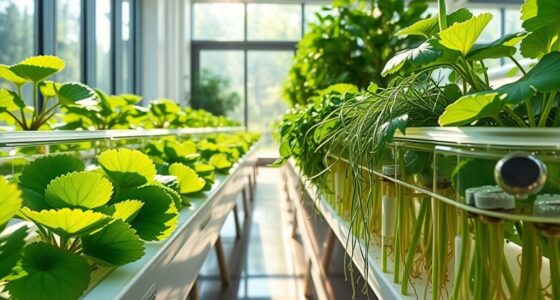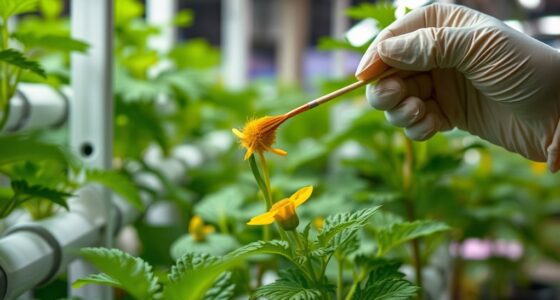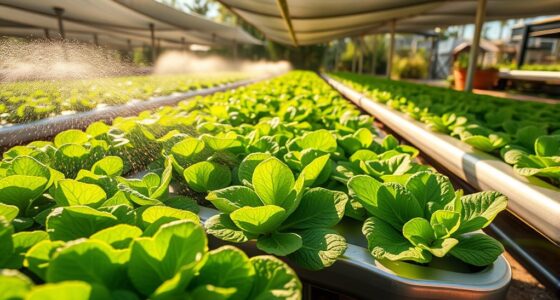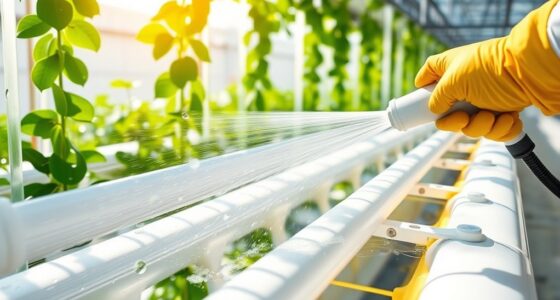To turbocharge your roots, aim for dissolved oxygen (DO) levels above 6 mg/L, as higher DO promotes faster root growth, better nutrient absorption, and overall plant health. Maintaining ideal DO prevents hypoxic stress and encourages denser, more vigorous roots. Right aeration methods like air stones or water movement help keep levels steady. If you want to harness the full potential of your plants, keep going for more tips on maximizing oxygen for root vitality.
Key Takeaways
- Maintaining dissolved oxygen (DO) levels above 6 mg/L optimizes root health and promotes vigorous growth.
- Adequate aeration prevents hypoxia, root stress, and disease, ensuring strong plant development.
- Regular monitoring of DO levels allows for timely adjustments to sustain ideal root environments.
- Incorporating aeration methods like air stones or diffusers boosts oxygen availability to roots.
- Enhancing soil aeration with organic matter and avoiding compaction increases pore spaces for better oxygen diffusion.

Enhancing dissolved oxygen (DO) levels in your hydroponic or soil systems can substantially boost root growth and overall plant health. When oxygen availability around roots improves, plants can absorb nutrients more efficiently, leading to stronger, more vigorous growth. Without adequate oxygen, roots can become stressed, leading to poor nutrient uptake, increased susceptibility to diseases, and stunted development. By optimizing DO levels, you create an environment where roots thrive, supporting the entire plant’s vitality.
Boost plant health and root growth by increasing dissolved oxygen levels in your systems.
In hydroponic systems, oxygen levels are often a limiting factor because water can hold only a certain amount of dissolved oxygen. Introducing aeration through air stones, diffusers, or pumps ensures oxygen continually replenishes in the nutrient solution. This constant supply prevents hypoxic conditions, where oxygen drops too low, which can cause roots to suffocate or rot. Maintaining high DO levels in hydroponics not only encourages rapid root elongation but also promotes the development of a dense, healthy root mass. The more oxygen available, the more energy roots can allocate toward growth rather than survival.
If you’re working with soil-based systems, enhancing oxygen involves improving soil aeration. You can do this by mixing organic matter into the soil, which creates pore spaces for air to reach roots more effectively. Avoid compacting the soil, as tightly packed soil limits oxygen diffusion. Using raised beds or incorporating perlite and other aerating amendments can greatly increase oxygen availability. Well-aerated soil encourages roots to explore a larger volume, increases microbial activity beneficial for nutrient cycling, and reduces the likelihood of root diseases caused by anaerobic conditions.
Monitoring DO levels is essential to optimize these interventions. You might use a dissolved oxygen meter to measure levels directly, especially in hydroponic setups. Ideally, DO should be maintained above 6 mg/L in hydroponic systems for ideal root health, but even slightly lower levels can be tolerated depending on the crop. For soil systems, ensuring good drainage and avoiding waterlogging helps maintain adequate oxygen levels. Remember, oxygen levels fluctuate with temperature, water movement, and organic matter decomposition, so regular checks and adjustments are necessary.
Ultimately, understanding and managing dissolved oxygen is a straightforward yet powerful way to turbocharge root growth. You don’t need complex equipment; simple aeration methods often suffice. Just keep the oxygen flowing, monitor your system, and watch your plants develop robust roots that support vigorous, healthy growth. With higher DO levels, you give your plants the best chance to reach their full potential from the ground up.
Frequently Asked Questions
How DO DO Levels Affect Root Disease Resistance?
Higher dissolved oxygen (DO) levels boost your roots’ resistance to disease by improving oxygen availability for root respiration and nutrient uptake. When DO levels are ideal, your roots stay healthier, stronger, and more capable of fighting off pathogens. Conversely, low DO causes stress, weakens roots, and makes them more susceptible to disease. Ensuring proper oxygen levels creates a vigorous, resilient root system that wards off infections effectively.
What Equipment Is Best for Measuring Soil Oxygen?
Think of soil oxygen measurement like checking the breath of your roots. A simple, reliable tool is a dissolved oxygen meter or portable soil oxygen sensor, which directly measures oxygen levels in the soil. You can also use a soil gas analyzer for detailed insights. Make sure your equipment is calibrated, easy to use, and suited to your soil type, so you get accurate readings that help optimize root health and prevent disease.
Can High DO Levels Harm Beneficial Soil Microbes?
High DO levels generally won’t harm beneficial soil microbes; in fact, they thrive with adequate oxygen. However, excessively high oxygen levels from over-aeration can disrupt the natural balance, potentially stressing some microbes. You should monitor DO levels to maintain ideal ranges, ensuring beneficial microbes flourish without creating an environment too rich in oxygen. Proper management promotes healthy microbial activity and supports overall soil health.
How Quickly DO Roots Respond to Changing DO Levels?
Roots react to changing DO levels almost instantly, like a switch flipping in a dark room. When oxygen increases, roots breathe easier, boosting their growth and nutrient uptake within hours. Conversely, a drop in DO can cause roots to slow down or even suffocate, with damage appearing within days. Your plants’ roots are highly responsive, thriving or suffering based on how quickly oxygen levels fluctuate around them.
Are There Crop-Specific Optimal DO Ranges for Roots?
Yes, there are crop-specific ideal DO ranges for roots. You should adjust oxygen levels based on the particular crop you’re growing, as some plants thrive in higher DO environments, while others prefer slightly lower levels. Monitoring and maintaining these specific ranges helps guarantee healthy root development, improves nutrient uptake, and boosts overall crop yield. Regularly testing your water or soil can help you keep these levels within the perfect range for each crop.
Conclusion
Remember, the right oxygen levels can truly boost your roots’ growth and health. By optimizing DO levels, you give your plants the turbocharge they need to thrive. Don’t forget, a penny saved is a penny earned — investing in proper oxygen management pays off in stronger, more resilient plants. Keep a close eye on your system, stay proactive, and watch your roots flourish like never before. With the right approach, success is well within your reach.










